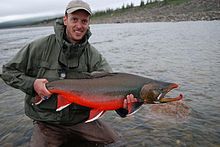Kype
A kype is a hook-like secondary sex characteristic which develops at the distal tip of the lower jaw in some male salmonids prior to the spawning season.
[3] The kype functions as a secondary sexual characteristic and influences the formation of dominance hierarchies at the spawning grounds.
The kype grows rapidly from bony needles proliferating from the tip of the dentary (the anterior and largest of the bones making up the lower jaw).
The speed at which the kype skeleton develops results in many osteoblasts and proteoglycans appearing along the growth zone.
[4] Some species of salmon are semelparous (they have a single reproductive bout before death) whereas others are iteroparous (they spawn multiple times after maturation).
[3] In some species, the development of the "kype" (in this study defined as the distance from the middle of eye to the tip of the snout) is used as an indicator of a difference in behavioural mating strategies.
Alternatively, jacks are presumably resident in their natal rivers their entire lives, reach sexual maturity precociously (after 2 years), and use a sneaking tactic, by darting from nearby refuges to steal fertilisations from hooknose males.
In the Atlantic salmon (Salmo salar), kype development is accompanied by a morphogenesis of bones and cartilages in the ethmoidal zone (the anterior region of the skull) changing the appearance of both jaws, the appearance of "breeding teeth" and resorption of scales (more so in males than females).



Female (above) and male in mating condition. Note that the male has a kype, enlarged snout, humped back and deeper, more extensive colouration.